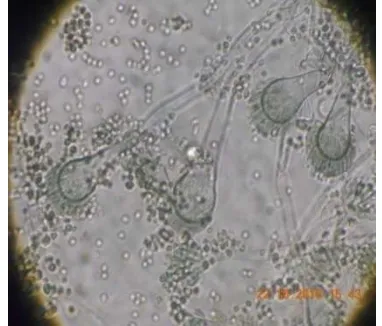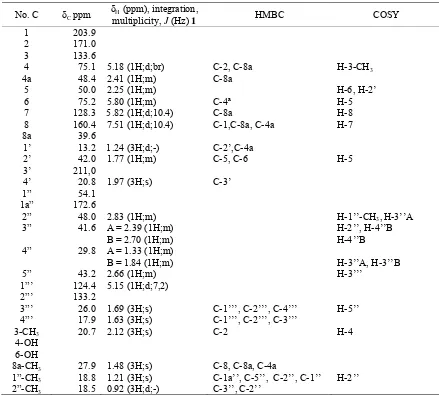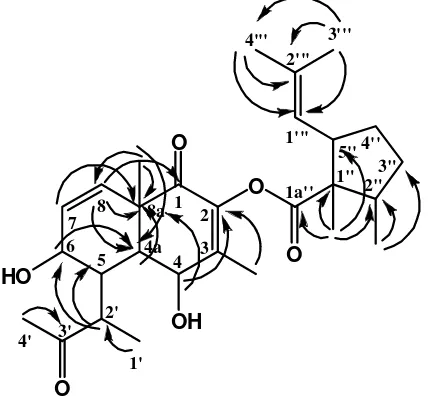124
SECONDARY METABOLITE OF
Aspergillus fumigatus
, ENDOPHYTIC
FUNGI OF THE MEDICINAL PLANT
Garcinia griffithii
Elfita
*), Muharni, and Tri Indah
Department of Chemistry, Faculty of Mathematics and Natural Sciences, Sriwijaya University, Indralaya, Palembang 30662, Indonesia
*)
E-mail: [email protected]
Abstract
The endophytic fungi Aspergillus fumigatus was isolated from the tissues of the fruits of Garcinia griffithii. The fungal strain was identified from the colony, and it was characteristic of cell morphology. The ethyl acetate extracts derived from fungus cultures showed major spots on TLC under UV light, which was continued to the isolation of the secondary metabolites. The structure of the isolated compound was elucidated on the basis of NMR analyses (1H-NMR,
13
C-NMR, HMQC, HMBC and H-H COSY).The compounds were identified as: 4,6-dihydroxy, 3,8a-dimethyl-1-oxo-5-(3’-oxobutan-2’-yl)-1,4,4a,5,6,8a-hexahydronaphthalen-2-yl-1”,2”-dimethyl-5”-(2”’-methylprop-1”’-enyl)cyclopentane- carboxylate.
Keywords: Aspergillus fumigatus, endophytic fungi, Garcinia griffithii, secondary metabolite
1. Introduction
Endophytes are microbes that colonize living, internal tissues of plants without causing any immediate negative effects [1]. They reside inside the tissues of nearly all healthy plants. The relationship that they establish with the plant varies from symbiotic to bordering on pathogenic [2]. They are synergistic to their host, and at least some of them are thought to be useful to the plant by producing special substances, such as secondary metabolites, that prevent the host from being attacked successfully by fungi and pests [3]. Via what appears to be their contribution to the host plant, the endophytes may produce a plethora of substances of potential use to modern medicine, agriculture, and pharmaceutical industry. The potential prospects of finding new drugs that may be effective candidates for treating newly developing diseases in humans, plants, and animals are great [4].
The genus Garcinia (Guttiferae) is known to produce a variety of biologically active metabolites especially xanthonoids, biflavonoids, triterpenoids, polyiso-prenylated benzophenon, lactones, and phenolic acids [5]. Some of them exhibited a wide range of biological activities such as cytotoxic, antifungal, antimicrobial, antioxidant, anti-inflammatory, and anti-HIV activities [6]. Garcinia griffithii T. Anders (locally named “kandis gajah” in Indonesia) is a medium-sized tree found in
South East Asia. No medicinal uses are recorded for this species, although it has been used as a fruit tree[7]. As part of a phytochemical study of our research, we have previously reported the presence of 1,5-dihydroxy-3,6-dimethoxy-2,7-diprenylxanthone to show anti-malarial activity; other compounds are 1,7-dihydroxyxanthone;
β-sitosterol-3-O-β-D-glucoside; stigmasterol-3-O-β -D-glucoside; 1,6-dihydroxy-3-methoxy-4,7-diprenylxanthone. Several antioxidant compounds have been isolated from
G. griffithii such as isoxanthochymol; 1,6,7-trihydroxyxanthone; and guttiferone I. This plant has also been used traditionally by local communities to treat various diseases including gout [8-12].
The present study is focused on isolation and determination of endophytic fungi from fruits of G. griffithii growing wildly in Lembah Arau, West Sumatra, which has allowed us to explore and to elucidate the structure of natural products produced by the endophytic fungi Aspergillus fumigatus.
2. Methods
Plant material and fungal isolation. Isolation of endophytic fungi was standardized and modified based on the method described by Debbab et al. [13]. Fruits of
in the Laboratory of Herbarium, Universitas Andalas (ANDA), Padang. The fruits were washed in sterilized distilled water twice. Surface sterilization was done by immersing the stems in 70% ethanol for 2 min (twice) followed by rinsing again twice in sterilized distilled water. Then, the fruit were cleaved aseptically into small segments (≈1 cm in length). The material was placed on a petri dish containing potato dextrose agar medium (PDA) supplemented with 100 µg/mL of chloramphenicol to suppress bacterial growth and then incubated at room temperature (25 °C). After several days hyphae growing from the plant material were then transferred to other plates, incubated again for 10 days, and periodically checked for culture purity. The fungal strain was identified based on the colony and the characteristic of cell morphology [14].
Potato dextrose broth (PDB) culture of isolated fungi. Ten flasks (1 L each) containing 500 mL of PDB medium were autoclaved. A small part of the medium from a petri dish containing the purified fungi was transferred under sterile conditions to the PDB medium. The fungi strain was grown on PDB medium at room temperature for two months.
Extraction, exploration and structure elucidation. The culture was extracted with 5 L ethyl acetate (twice). Evaporation of the extract resulted a dry extract, which was applied to chromatograph over a silica gel column with n-hexane : ethyl acetate as solvent (gradient elution). Based on detection by TLC (SiO gel F254, Merck, Darmstadt, Germany) using n-hexane : EtOAc (4 : 6) as a solvent system, the collected fractions were combined, and subjected to recolumn over a silica gel with n-hexane : ethyl acetate (4 : 6) to obtain pure compound. The molecular structure is identified by spectroscopic methods including 1H-NMR, 13C-NMR, HMQC, HMBC, and COSY.
3. Results and Discussion
Characterization of endophytic fungi. Characterization of the macroscopic was analyzed by colony morphology and the characteristic of cell morphology. The colony morphology was determined by growing the isolates of the fungus in three different mediums, namely Czapez dox agar (CDA), malt extract agar (MEA), and potato dekstrose agar (PDA). The cell morphology was determined by observing the non-reproductive structures, non-reproductive structures, conidia, and conidiophores, and it was compared with literature, that the fungi is A. fumigatus. The results of characterization are shown in Figure 1 and 2.
Extraction and exploration. Ethyl acetate extract containing secondary metabolite was concentrated under reduced pressure to give crude extract 6,42 g. TLC results of EtOAc extract indicates that there is one
Figure 1. Fungi Growth on Different Mediums (CDA, MEA, and PDA Medium)
Figure 2. Morphology of Cells Seen Under a Microscope
major component, column chromatography of EtOAc extract on silica gel with n-hexane-EtOAc of increasing polarity as eluent. Fractions, which gave the same Rf on TLC, were combined and gave four column fractions (F1-F4). F2 fraction was further rechromatographed with n-hexane-EtOAc (6:4) to afford 26 fraction which were combined to three fractions (F2.1-F2.3). F2.3 fraction was purified by rechromatographed to yield compound 1 (62 mg).
Structure elucidation. Compound 1 was isolated as a white powder. The 13C NMR and HMQC spectra of 1
revealed 28 signals: eight methyl (at δC 13.2; 17.9; 18.5;
18.8; 20.8; 20.7; 26.0; and 27.9 ppm), two methylene (at
δC 29.8 and 41.6 ppm), ten methyne (at δC 42.0; 43.2;
48.0; 48.4; 50.0; 75.1; 75.2; 124.4; 128.3; and 160.4 ppm) and eight quaternary carbon atoms including three keto carbonyl carbon atoms (at δC 172.6; 203.9; and
211.0 ppm), three sp2 carbon atoms (at δC 133.2; 133.6;
and 171.0 ppm), and two sp3 carbon atoms (at δC 39.6
and 54.1 ppm). Complete assignment of carbon and proton were made by analysis 2D NMR shown in Table-1.
The 1H-13C HMBC correlations from the eight methyl protons were at δH 1.24 ppm (H-1’) to δC 42.0 ppm
Tabel 1. The NMR Data of Compound 1, Recorded at 1H-500MHz; 13C-125 MHz in Methanol-d4
No. C δC ppm
δH (ppm), integration,
multiplicity, J (Hz) 1 HMBC COSY
1 203.9 2 171.0 3 133.6
4 75.1 5.18 (1H;d;br) C-2, C-8a H-3-CH3
4a 48.4 2.41 (1H;m) C-8a
5 50.0 2.25 (1H;m) H-6, H-2’
6 75.2 5.80 (1H;m) C-4ª H-5
7 128.3 5.82 (1H;d;10.4) C-8a H-8
8 160.4 7.51 (1H;d;10.4) C-1,C-8a, C-4a H-7
8a 39.6
1’ 13.2 1.24 (3H;d;-) C-2’,C-4a
2’ 42.0 1.77 (1H;m) C-5, C-6 H-5
3’ 211,0
4’ 20.8 1.97 (3H;s) C-3’
1” 54.1 1a” 172.6
2” 48.0 2.83 (1H;m) H-1’’-CH3,H-3’’A
3” 41.6 A = 2.39 (1H;m)
B = 2.70 (1H;m)
H-2’’, H-4’’B H-4’’B
4” 29.8 A = 1.33 (1H;m)
B = 1.84 (1H;m) H-3’’A, H-3’’B
5” 43.2 2.66 (1H;m) H-3’’’
1”’ 124.4 5.15 (1H;d;7,2)
2”’ 133.2
3”’ 26.0 1.69 (3H;s) C-1’’’, C-2’’’, C-4’’’ H-5’’
4”’ 17.9 1.63 (3H;s) C-1’’’, C-2’’’, C-3’’’
3-CH3 20.7 2.12 (3H;s) C-2 H-4
4-OH 6-OH
8a-CH3 27.9 1.48 (3H;s) C-8, C-8a, C-4a
1”-CH3 18.8 1.21 (3H;s) C-1a’’, C-5’’, C-2’’, C-1’’ H-2’’
2”-CH3 18.5 0.92 (3H;d;-) C-3’’, C-2’’
2’’’); and 17.9 ppm (C-4’’’), δH 2.12 ppm (H-3-CH3) to
δC 171.0 ppm (C-2), δH 1,97 ppm (H-4’) to δC 172.6
ppm (C-3’), δH 1.48 ppm (H-8a-CH3) to δC 160.4 (C-8);
39.6 (C-8a); and 48.4 ppm (C-4a ), δH 1.21 ppm
(H-1’’-CH3) to δC 211.0 (C-1a’’); 43.2 (C-5’’); 48.0 (C-2’’);
and 54.1 ppm (C-1’’), δH 0.92 ppm (2”-CH3) to δC 41.6
(C-3’’) and 48.0 ppm (C-2’’), δH 1.63 ppm (2”’-CH3) to
δC 124.4 (C-1’’’); 133.2 (C-2’’’); and 26.0 ppm (C-3’’’).
The HMBC correlations from the methyl protons indicated that the methyl groups were attached to C-3, C-8a, C-2’, C-3’, C-1’’, C-2’’, and two methyl groups were attached to C-2’’’.
The HMBC correlations from the sp2 methyne protons were at δH 7.51 ppm (H-8) to δC 203.9 1); 39.6
(C-8a); and 48.4 ppm (C-4a ), δH 5.82 ppm (H-7) to δC 39.6
ppm (C-8a). According to the chemical shift of H-7 and H-8 and the HMBC correlations from the sp2 methyne protons, the presence of a double bond was indicated to C-7 and C-8.
The HMBC correlations from the sp3 methyne protons were at δH 5.18 ppm (H-4) to δC 171.0 (C-2) and 39.6
ppm (C-8a), δH 2.41 ppm (H-4a) to δC 39.6 ppm (C-8a),
δH 5.80 ppm (H-6) to δC 48.4 ppm (C-4a ), δH 1.77 ppm
(H-2’) to δC 50.0 (C-5) and 75.2 ppm (C-6).
Furthermore, the HMBC correlations indicated that the sp3 methyne protons at δH 5.18 ppm (H-4) and 5.80 ppm
(H-6) revealed the connectivity from sp2 carbons of C-3 and C-7 respectively. The HMBC correlation of compound 1 is shown in Figure 3.
The 1H-1H COSY spectrum revealed the presence of a butyl group and a cyclopenthenegroup with correlation proton at δH 1.69 ppm (H-3’’’) to δH 2.66 (H-5’’) namely
long-range COSY, which is allylic coupling (5J).
Furthermore, correlation at δH 2.12 ppm (H-3-CH3) to
δH 5.18 ppm (H-4) and δH 2.83 ppm (H-2’’) to δH 1.21
(H-1’’-CH3), which is allylic coupling (4J). This
O
The COSY spectrum also revealed the presence of two methylene groups in cyclopenthane with correlation H-2” to H-3” and H-3” to H-4” (3J).The COSY correlation of compound 1 is shown in Figure 4.
By combining the results obtained by the different spectrometric methods (1H-NMR, 13C-NMR, HMQC, HMBC and COSY), it was proposed that C28H40O6 was
the molecular formula for compound 1. The molecular formula indicated nine degrees of unsaturation. The NMR spectrums for 1 revealed that six of the nine unsaturation degrees were attributed to three carbonyls,
Figure 3. The HMBC Correlation of Compound 1
Figure 4. The 1H-1H COSY Correlation of Compound 1
and three double bond. Thus, the remaining unsaturation degree came from a ring. Furthermore, the chemical shift of C-4 and C-6 indicated the presence two hydroxyl groups. Other than that, chemical shift of C-2 indicated the presence of ester group. The above data suggested the structure of compound 1 as 4,6-dihydroxy, 3,8a-dimethyl-1-oxo-5-(3’-oxobutan-2’-yl)-1,4,4a,5,6,8a-hexahydronaphthalen-2-yl-1”,2”-dimethyl -5”-(2”’-methylprop-1”’-enyl)cyclopentanecarboxylate.
Compound 1 was not found in the host plant G. griffithii. The structure which has A and B rings similar to rings A and B in the xanthone, while ring C in xanthone is the result of this cyclizationand aromatization of compound 1. Search by ScinceFinder found that this compound is new.
4. Conclusion
The endophytic fungi A. fumigatus from the fruit of the medicinal plant G. griffithii has produced a secondary metabolite. Based on NMR spectroscopic analysis including 1H-NMR, 13C-NMR, HMQC, HMBC and COSY, the compounds are 4,6-dihydroxy, 3,8a- dimethyl-1-oxo-5-(3’-oxobutan-2’-yl)-1,4,4a,5,6,8a-he-xahydronaphthalen-2-yl-1”,2”-dimethyl- 5”-(2”’-methyl-prop-1”’-enyl)cyclopentanecarboxylate.
Acknowledgement
The authors are grateful to the Directorate General of Higher Education for funding the research through the Strategis Nasional Grant in 2010 and 2011, with the headline: "Produksi Sediaan Obat Tradisional Terstandar untuk Asam Urat dari Mikroba Endofitik Tumbuhan Kandis Gajah (Garcinia griffithii T. Anders)”.
References
[1] C.W. Bacon, J.F. White, Microbial Endophytes, Marcel Dekker, New York, 2000, p.487.
[2] G.A. Strobel, Biotechnol. 22/4 (2002) 315.
[3] T. Thongchai, L. Chunhua, S. Yuemao, J. Microbiol. 151 (2005) 1691.
[4] G. Strobel, B. Daisy, Microbiol. Mol. Biol. Rev. 67/4 (2005) 491.
[5] G.S. Joseph, G.K. Jayaprakasha, A.T. Selvi, B.S. Jena, K.K. Sakariah, Int. J. Food Microbiol. 101 (2005) 153.
[6] N. Nilar, L.H.D. Nguyen, G. Venkatraman, K.Y. Sim, L.J. Harrison, Phytochemistry 66 (2005) 1718.
[8] E. Elfita, M. Muharni, L. Madyawati, D. Darwati, W. Ari, S. Supriyatna, H.H. Bahti, D. Dachriyanus, P. Cos, L. Maes, K. Foubert, S. Apers, L. Pieters, Phytochemistry 70 (2009) 907.
[9] E. Elfita, S. Supriyatna, H.H. Bahti, D. Dachriyanus, Indonesian J. Chem. 8/1 (2008) 97.
[10] E. Elfita, S. Supriyatna, H.H. Bahti, D. Dachriyanus, Jurnal Ilmu Dasar. 9/2 (2008) 142.
[11] E. Elfita, S. Supriyatna, H.H. Bahti, D. Dachriyanus, Biosfera. 24/1 (2007) 24.
[12] E. Elfita, S. Supriyatna, H.H. Bahti, D. Dachriyanus, Jurnal Ilmu Kefarmasian Indonesia 9/1 (2011) 35. [13] A. Debbab, A.H. Aly, R.A.E. Ebel, W.E.G.
Müller, M. Mosaddak, A. Hakiki, R. Ebel, P. Proksch, Biotechnol. Agron. Soc. Environ. 13/2 (2009) 229.


